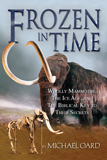Messages on Stone
Originally published in Creation 19, no 2 (March 1997): 20-23.
It was once held that mammoths and mastodons became extinct 30,000 to 40,000 years ago.
Mammoths and mastodons
It was once held that mammoths and mastodons became extinct 30,000 to 40,000 years ago. When flint spear points attributed to the ‘Clovis’ culture were found in mammoth bones,1 the evolutionist scientific community had to concede reluctantly that these colossal beasts were being hunted in America some 10,000 years ago by their reckoning. However, there is evidence which suggests that these huge pachyderms were in existence at a much more recent date.
The Anasazi Indians lived in the south-west of the United States from roughly 150 BC to AD 1200. They had first-hand knowledge of these massive beasts. Near Moab, Utah, is a pictograph of a mammoth showing many of its characteristic features.2 There are also other examples in Shay Canyon on the Colorado Plateau3 and near Thousand Lake Mountain in central Utah.4
An authority in Indian rock art writes that ‘no rock art known to be older than about 1,000 years resembles the sophistication of design and technique that was used in making these mammoths.’5 The preponderance of evidence indicates these figures were made during the period of the Anasazis.
The artist obviously saw a live elephantid of some sort still alive in the region only hundreds of years ago.
Nor is that all. Two carved stone slabs found in Indian ruins at Flora Vista, New Mexico, show meticulously chiselled elephantine figures, surrounded by numerous symbols and pictures. Earl H. Morris, a noted authority on south-western Indian artifacts, says the ruins date at about ad1200, so the ancient artist could not have seen his elephant in a circus, zoo or a book. An excavated mammoth skeleton would not show that it had a trunk, so the artist obviously saw a live elephantid of some sort still alive in the region only hundreds of years ago.
All this is no surprise, since the Bible indicates that there have been only a few thousand years since the Great Flood of Noah's day. The extinction of mammoths (and dinosaurs) must have occurred sometime in the last 4,000 or so years.
Dinosaurs and flying reptiles
However, evolutionists and other long-agers believe dinosaurs became extinct more than 60 million years before the first man appeared, so they cannot admit that any ancient rock art depicts dinosaurs.
When I was in Peru recently, Dr Javier Cabrera Darquea, a research professor at Ica National University, gave me a stone which he said had been found on the Nazca desert plains. This has a startlingly accurate depiction of two dinosaurs, Triceratops and a therapod dinosaur somewhat similar to Tyrannosaurus rex or Allosaurus. Because Triceratops and T. rex are both ‘favorites’ in popular dinosaur lore (often depicted as sparring partners), it raises the question of a modern forgery. However, the stone, of high density, smooth andesite (a volcanic rock), has several areas deeply encrusted with desert sand, especially covering some of the engraved areas showing leaves. It has a film of oxidation over it, and the segment of T. rex's lower leg and foot are well worn. The fact that the therapod is not a good representation of T. rex (the front legs are too long) is further evidence against a modern forgery. The frill-like treatment along the back suggests the artist may have been drawing something like Spinosaurus.
There are examples which are impossible to dismiss as anything other than the work of ancient artists. Fran Barnes, a recognized authority on rock art of the American South-West, writes, ‘In the San Rafael Swell, there is a pictograph that looks very much like a pterosaur, a Cretaceous flying reptile.’6
While some say it may be a bird, the presence of a prominent head crest and what appears to be a long tail suggests otherwise. It is intriguing to note that not far away from this site, the University of Ohio quarried a fossil pterosaur.7
Sioux Indians have long featured the ‘Thunder Bird’ in their mythology, and always draw it as unmistakably similar to the pterosaur Pteranodon.8
A petroglyph in Arizona's Havasupai Canyon shows a creature with the unmistakable upright stance and balancing tail of some of the known dinosaurs, but unlike any other creature.9
Barnes writes,10 ‘There is a petroglyph in Natural Bridges National Monument that bears a startling resemblance to a dinosaur, specifically a Brontosaurus, with a long tail and neck, small head and all.’ Note that Barnes, who despises creationists, knows that this work shows every sign of age, such as pitting and weathering, etc. If there was an ‘orthodox’ way to explain these sorts of finds away, he would have tried to do so.
Such messages left by ancient artists (and we have only shown a small sample here of the many reported from around the world) testify to the reliability of the biblical record, and the bankruptcy of the idea of evolution and long ages of ‘prehistory’.
Rock art dating
Although it is not possible to assign absolute dates to rock art, it is possible to narrow the time span in which a particular figure might fall. There are many methods of dating rock art that give us a clue to its relative age. At times it is suggested that rock art of extinct animals is the work of clever hoaxers. Several dating methods dismiss this possibility.
Desert varnish is an accumulation of minerals that build up in glyphs and on canyon walls. This dark coating, or varnish, takes a considerable amount of time to accumulate. It can be generalized that if the varnish on a glyph is as dark as its surrounding, undisturbed surface, then the glyph is significantly old. One could easily tell if a glyph was recent because it would clearly stand out as very light against a dark background.
Weathering. Erosion of exposed rock by wind and water wears the surface of the drawing and gives it a pockmarked appearance. A newer glyph has a bright, fresh appearance. The degree of weathering provides a clue to the age, and the weathering factor is considered impossible to fake.
Lichens. Studying lichens (common plants consisting of an alga and a fungus living together), which form a scaly adherence on rock surfaces, helps us to date rock art. Lichenometry, the study of lichen cover patterns, colonization and growth, is based on the slow growth rate of lichens on exposed surfaces and the long life expectancy of their colonies. In certain habitats lichens may reach their final size only after several thousand years. Lichenometry can help tell us if a particular piece of rock art is hundreds of years old. A modern hoaxed glyph would have no lichen growth.
Footnotes
- Hal Bowser, When Elephants Roamed the Range, Science Digest, p. 63, June 1983.
- Grant Campbell, Rock Art of the American Indian, Outbooks, Golden (Colorado), p. 117, 1981. The Moab Mammoth Pictograph, Scientific Monthly, pp. 378–379, 1935.
- Larry Agenbroad, Quaternary Geochronology and Distribution of Mammuthus on the Colorado Plateau, Geology, 17(9):861–866, September 1989.
- William M. Stokes and William L. Stokes, Messages on Stone: Selections of Native Western Rock Art, Starstone Publishing Co, Salt Lake City, (Utah), p. 30, 1980.
- F. Barnes, in Barnes and Pendleton, Canyon Country Prehistoric Indians—Their Culture, Ruins, Artifacts and Rock Art, Wasatch Publishers, Salt Lake City, Utah, 1995.
- F. Barnes, in Barnes and Pendleton, Canyon Country Prehistoric Indians—Their Culture, Ruins, Artifacts and Rock Art, Wasatch Publishers, Salt Lake City, Utah, 1995.
- Owen McClenahan, Utah's Scenic San Rafael, Castle Dale Publishers, Utah, 1986.
- The Great Dinosaur Mystery and the Bible (Films for Christ), video and 16 millimetre film. The thunder bird motif associated with Sioux jewelry, etc. is common knowledge.
- This type of dinosaur reconstruction is a little out of fashion since it was realized (from bone structure and the absence of drag marks on dinosaur trackways) that most dinosaurs held their tail horizontally while walking. However, the tripod stance is still the obvious one for a creature with this anatomy while it is standing, or in particular reaching up, when the tail would be used for extra balance.
- F. Barnes, in Barnes and Pendleton, Canyon Country Prehistoric Indians—Their Culture, Ruins, Artifacts and Rock Art, Wasatch Publishers, Salt Lake City, Utah, 1995.
Recommended Resources

Answers in Genesis is an apologetics ministry, dedicated to helping Christians defend their faith and proclaim the good news of Jesus Christ.
- Customer Service 800.778.3390
- © 2024 Answers in Genesis




